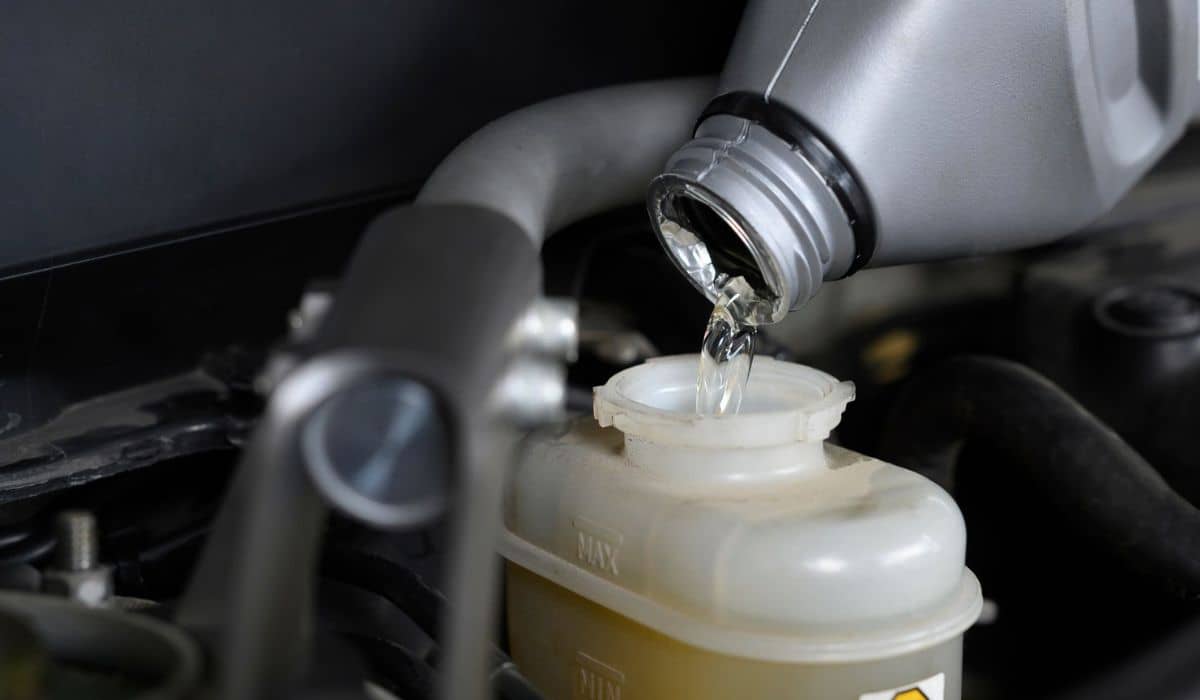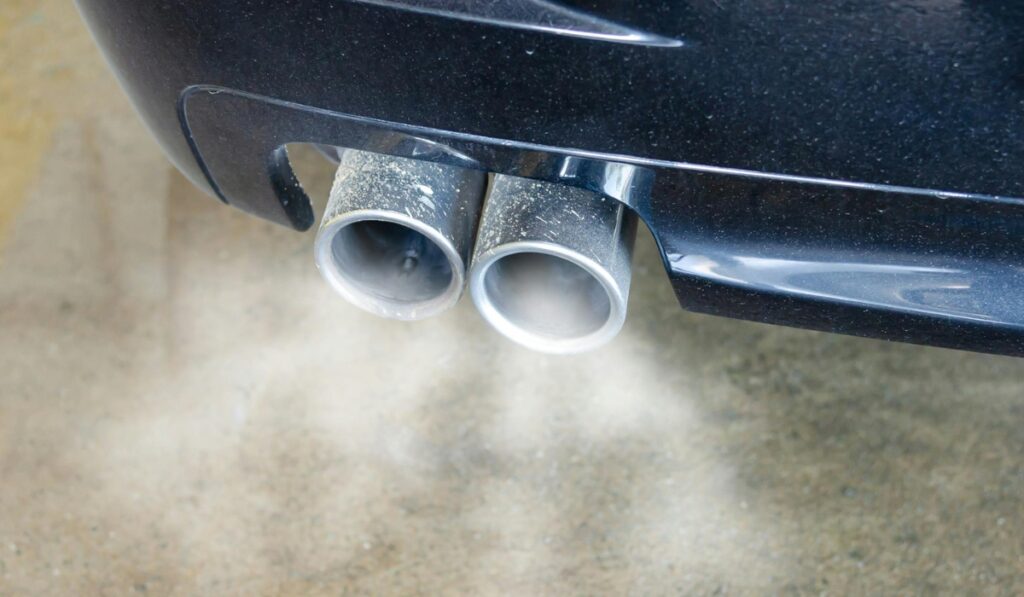Brakes, the unsung heroes of road safety, often take the backseat when it comes to vehicle maintenance. While we pay attention to tire tread and engine health, brake fluid, a linchpin in the braking system, often escapes our scrutiny.
In this exploration, we’ll delve into the low brake fluid symptoms and the potential perils they pose.
Brake fluid, an unsung hero in the automotive symphony, operates quietly in the background, facilitating the translation of foot-on-pedal force into the measured dance of brake pads and rotors.
It’s the hydraulic conductor ensuring your vehicle’s braking performance hits the right notes. Overlooking its levels could turn this symphony into a discordant cacophony on the road.
In this comprehensive guide, I’ll draw from my own encounters with low brake fluid, shedding light on the symptoms that act as early warnings. Armed with this knowledge, you can intercept potential brake disasters before they crescendo into major issues.
| Topic | Content |
|---|---|
| Role of Brake Fluid | Hydraulic conductor for optimal deceleration. |
| Maintenance Frequency | Regular checks and replacements as per manufacturer recommendations. |
| Warning Signs | Longer stopping distances, soft brake pedal, warning lights, strange noises. |
| Identifying Brake Fluid Leak | Puddles, wet components, reduced reservoir levels, soft pedal. |
| Importance of Addressing | Prevents compromised performance and potential safety hazards. |
Understanding Brake Fluid and Its Importance
The Role of Brake Fluid
Brake fluid, that often-neglected elixir in our braking system, plays a pivotal role in conveying hydraulic force. Picture pressing the brake pedal as orchestrating a symphony—the fluid transmits the conductor’s directive to the brakes, ensuring a harmonious deceleration.
Types of Brake Fluid
Not all brake fluids are cut from the same fabric. DOT 3, DOT 4, and DOT 5.1 represent different chapters in the brake fluid saga.
Each type brings its own characteristics to the table, demanding a discerning eye from vehicle owners. Consult your manual or a pro to unravel the brake fluid tapestry woven specifically for your vehicle.
Characteristics of Brake Fluid
Brake fluid isn’t a passive participant; it must meet stringent criteria to perform its hydraulic ballet effectively. Heat resistance, viscosity, and compatibility with brake system materials are non-negotiable traits.
It must endure the fiery dance of braking without losing its fluidity or compromising the integrity of rubber seals.
Importance of Regular Maintenance
Regular maintenance of brake fluid is akin to tuning your instrument before a performance. Over time, moisture and debris can infiltrate the fluid, muddying its composition.
This contamination weakens the fluid’s ability to transmit force, endangering your braking power. Regular checks and timely replacements, as per your vehicle manufacturer’s directives, ensure your brake fluid remains the virtuoso it’s meant to be.
Low Brake Fluid Symptoms
Monitoring brake fluid levels is essential for vehicle safety and performance. A skilled mechanic should check and replace your brake fluid if you experience any of the symptoms. By checking brake fluid levels, you can maintain your brakes working and keep yourself and others safe.
Spongy Brake Pedal In Use
A mushy brake pedal is a sign of insufficient brake fluid. Thus, pressing the brake pedal seems mushy and unresponsive. This may indicate that the brake fluid is insufficient to provide brake pressure.
This can diminish brake reactivity and increase vehicle stopping distance, making it unsafe. Check and refill brake fluid quickly to fix this issue.
Air bubbles in the brake lines can also cause a mushy brake pedal. Air can enter the brake system when brake fluid levels are low. This air can block brake fluid from flowing and create braking pressure.
To remove air bubbles and restore brake function, bleeding the brakes may be necessary. To avoid a spongy brake pedal and brake failure while driving, check and maintain brake fluid levels.
Brake Warning Light Appears Unexpectedly
The dashboard brake warning light unexpectedly turning on is another sign of low brake fluid. This is unusual and suggests a brake system issue, which drivers should be concerned about.
This warning light should be addressed immediately since insufficient brake fluid might affect braking performance and endanger the driver and passengers.
Moreover, ignoring the warning light may cause more costly brake issues. If the brake warning light comes on, check and replace the brake fluid. If the light stays on, a mechanic should check the brake system for a bigger problem.
Stopping Farther Than Usual
Low brake fluid can also increase stopping distance. When you engage the brakes, the vehicle stops slower than usual. Emergency braking scenarios, where seconds matter, can be perilous.
Keep adequate space between your car and the one in front of you to allow for a longer stopping distance, but if the distance needed to stop increases significantly, it may indicate low brake fluid.
Low brake fluid causes increased stopping distances for several reasons. braking fluid is necessary for hydraulic pressure, which keeps the braking system working. Lack of fluid reduces pressure, preventing the brakes from engaging fully to stop the car.
Low braking fluid can also generate air bubbles in brake lines, reducing brake performance. If you notice a greater stopping distance than usual, have a professional examine your braking system for road safety.
Braking Grinding Or Screeching
Drivers with low brake fluid may hear grinding or squealing while braking. This scary noise frequently suggests a braking system problem. Low brake fluid levels can accelerate brake pad wear and grind metal rotors.
Brake pads that need replacement might potentially cause this. The brake pads wearing down and the metal indicator rubbing against the rotor might also cause squealing.
In either instance, immediate brake system inspection and servicing are necessary to prevent further damage and assure safe braking.
Ignoring grinding or screaming sounds when braking can be dangerous. It can cause costly repairs and threaten vehicle safety. Low brake fluid causes the brakes to engage less forcefully, increasing stopping distances.
Emergency stopping scenarios require quick and efficient stopping, making this perilous. For effective brake operation, drivers must pay attention to any unexpected brake noises and rectify them immediately.
Brake fluid checks and topping off can also prevent these symptoms and provide a safe and reliable braking system.
Leaking Brake Fluid Under Vehicle
Leaking brake fluid under the vehicle is a frequent low brake fluid sign. Worn brake lines, brake callipers, or brake master cylinders might cause this. Brake fluid leaks can compromise the braking system, causing risk.
Other components like brake pads and rotors can be damaged. To minimise further damage and assure vehicle safety, brake fluid leaks must be addressed immediately.
A competent mechanic should inspect your vehicle quickly if you find brake fluid spilling under it. Ignoring this issue might reduce braking power, making vehicle stopping unsafe.
Lack of brake fluid can also cause air to enter the braking system, making the brake pedal mushy and unresponsive. This may necessitate replacing the leaking component and other braking system elements, which might be expensive.
Checking the brake fluid level and fixing leaks can prevent these difficulties and keep your car safe.
Weak Brakes And Reactivity
A drop in braking power and response is critical. It might be caused by worn brake pads, air in the brake lines, or a faulty braking system. Leaks can lower brake fluid levels, reducing power and responsiveness.
The braking fluid transfers force from the brake pedal to the brake pads, which press on the wheels to slow or stop the vehicle.
This process slows down without enough brake fluid, making vehicle stopping harder. To preserve braking performance, leaks and low brake fluid levels must be addressed.
Brake Fluid Low Indicator
A vehicle’s dashboard usually displays a low brake fluid level signal. This indication warns drivers when brake fluid is severely low, requiring immediate care. If the indicator light comes on, have a professional mechanic check the brake system because it may be caused by a problem.
Leaving a low brake fluid level might cause braking power and responsiveness loss. Emergency scenarios require quick and efficient braking, making this perilous.
Low brake fluid levels might damage other brake system components, requiring costly repairs. For safety and maximum braking system operation, drivers should periodically check brake fluid levels and fix any leaks or low levels.
Squishy Brake Pedal
A squishy or mushy brake pedal indicates low brake fluid. Brake fluid generates pressure to contact brake pads and halt the vehicle. Low brake fluid pressure prevents full brake engagement, resulting in a soft brake pedal. It can increase stopping distance and diminish vehicle control, making this risky.
A spongy brake pedal might be dangerous to ignore. If not treated quickly, it can cause costly repairs and endanger the driver and passengers. To avoid soft or mushy brake pedals, drivers should check and fill off their brake fluid levels regularly.
If this symptom occurs, a professional mechanic must inspect the brake system to find the source and prevent further problems.
Potential Causes of Low Brake Fluid
As a car enthusiast, the intricacies of a vehicle’s braking system have always fascinated me. In this exploration, we’ll dissect the potential causes behind low brake fluid, unraveling the mysteries that could compromise not only the performance of your brakes but, more importantly, your safety on the road.
Brake System Leaks
The tangle of a vehicle’s brake system, while robust, is not impervious to wear and tear. Over time, components such as brake lines, calipers, and master cylinders may succumb to cracks or corrosion, giving rise to the insidious phenomenon of fluid leakage.
Picture this: a silent drop-by-drop escape of brake fluid, a subtle betrayal beneath your vehicle. Signs of fluid pooling or an unexpected dip in brake fluid levels are the clandestine signatures of a brake system leak.
Worn Brake Pads
Brake pads, the unsung heroes of deceleration, wear down gradually with each press of the pedal. What many overlook is the symbiotic relationship between worn brake pads and diminishing brake fluid levels.
As the pads erode, the increasing gap between pad and rotor demands more fluid to maintain braking efficacy. This incremental demand, akin to a quiet siphoning, can go unnoticed until it manifests in reduced brake fluid levels—a reminder to engage in regular brake inspections.
Faulty Master Cylinder
The master cylinder, a linchpin in the hydraulic symphony of brakes, can turn rogue. When this crucial component falters or harbors internal leaks, it orchestrates a slow but steady decline in brake fluid levels.
Visualize a soft brake pedal or inconsistent braking performance as the master cylinder’s desperate Morse code, signaling the need for immediate attention.
Boiling Brake Fluid
In the event of extreme braking, where heavy application of brakes or prolonged use pushes the system to its limits, a sinister transformation occurs—brake fluid boiling. The excessive heat generated metamorphoses the fluid into vapor, a phenomenon aptly named “brake fade.”
This ballet of boiling fluid can lead to a loss of braking power and, concurrently, a reduction in fluid levels. It’s a reminder that even the most essential components can succumb to the heat of battle.
Incorrect Fluid Level Initially
In the realm of routine maintenance, errors can occur. Sometimes, low brake fluid levels are not a result of wear or malfunction but a consequence of improper filling during service or repair work.
Imagine the dissonance created when a crucial component is inadequately fueled. To avoid this pitfall, meticulous attention is needed to ensure that your vehicle’s brake fluid is filled to the recommended level post any service intervention.
Remember, the causes of low brake fluid are not mere technicalities; they are narratives told by your vehicle. Listening to these stories is not just an act of automotive empathy but a commitment to your safety.
Steps to Address Low Brake Fluid
Having unveiled the potential causes behind low brake fluid, the next step is to navigate the waters of resolution. Here are the steps you can take to address this critical issue and ensure that your braking system remains a reliable guardian on the road.
Check the Brake Fluid Level
Embark on this journey by locating your vehicle’s brake fluid reservoir—a sentinel near the firewall on the driver’s side of the engine compartment.
As you unveil the reservoir cap, a revelation awaits. Check the fluid level; if it languishes below the recommended mark, proceed to the next chapter of your brake fluid odyssey.
Identify and Fix Leaks
The next chapter involves the role of a detective. Inspect your brake system, scrutinizing every nook and cranny for visible signs of leakage.
Imagine this inspection as a quest for elusive clues—wet spots, fluid accumulation near the wheels, or the master cylinder revealing its secrets. If a leak unveils itself, become the protagonist and address it promptly to halt further fluid loss.
Top up with Fresh Brake Fluid
With leaks resolved, it’s time to infuse vitality back into your braking system. Reach for a high-quality brake fluid, a elixir recommended by your vehicle manufacturer.
Pour it with care, like a potion, into the reservoir until it mirrors the recommended level. Be cautious; even a drop misplaced can mar painted surfaces, turning your healing elixir into a corrosive agent.
Bleed and Flush the Brake System
The narrative takes a turn towards the intricate. If suspicions linger about air infiltrating your brake system or if a considerable duration has passed since your last brake flush, bleeding and flushing enter the scene.
Picture this as a ceremonial purging, akin to a purification ritual for your braking system. But beware, this is not a solo act; it requires the expertise of a mechanic or a script from your vehicle’s manual.
Test Your Brakes
As the curtain descends on your brake fluid saga, it’s time for the final act—a test. Picture yourself in a safe haven, devoid of traffic, where you can unfurl the potential of your revitalized braking system.
Apply the brakes gradually, feeling the firmness and responsiveness. Listen to the quiet hum of reassurance as you navigate the terrain.
FAQ
What Does Brake Fluid Do?
Brake fluid is essential to a vehicle’s braking system. Pressing the brake pedal feeds force through the brake fluid to the braking mechanism for regulated and effective deceleration. It converts your foot’s pedal energy into mechanical action to slow or stop your car.
How Often To Check And Change Brake Fluid?
Brake fluid inspections and replacements are essential vehicle maintenance. These checkups should follow your vehicle’s owner’s manual’s schedule.
Over time, moisture and debris can taint brake fluid, reducing its performance. Following the manufacturer’s instructions can prevent such issues, maintain consistent braking performance, and improve road safety.
What Are Low Brake Fluid Symptoms?
Warning signals indicate low brake fluid. Longer stopping distances, mushy brake pedals, brake fade, and dashboard warning lights are examples. Low brake fluid can also cause odd braking noises and vibrations. These signals allow you to solve potential faults quickly and protect your vehicle’s braking performance.
How To Do Brake Fluid Leak Detection?
Visual examinations and clues can identify brake fluid leaks. Look for puddles or drips under the car, especially near the wheels or brake lines. Check callipers and master cylinders for moisture.
Reduced reservoir brake fluid levels without exterior leakage may indicate an interior leak. Air entering the hydraulic system from a leak may cause the brake pedal to feel soft or spongy.
Why Treat Low Brake Fluid?
Low brake fluid affects your vehicle’s safety and performance, thus it must be addressed. Lack of brake fluid can cause brake fade, longer stopping distances, and poor brake efficiency, especially during extended braking.
Checking low brake fluid levels prevents accidents, provides reliable braking, and improves road safety. Every driver should prioritise braking system health.
Conclusion
In the intricate dance of vehicular safety, low brake fluid is the stealthy partner threatening to disrupt the choreography. This guide, a roadmap through the nuances of brake fluid symptoms, is your compass to navigate potential pitfalls.
Diminished brake performance, changes in brake pedal feel and response, warning lights and indicators, leaking brake fluid, strange noises, and vibrations—all are the vehicle’s Morse code signaling low brake fluid levels.
Regular checks, swift interventions, and professional consultations form the orchestra that ensures your brakes resonate with reliability and safety.
As a steward of your vehicle, embrace the responsibility of regular maintenance. Beyond monitoring brake fluid levels, inspect brake pads, rotors, and other components with the diligence of a curator.
In this narrative, safety is the protagonist; don’t let the symptoms of low brake fluid play the role of an unaddressed antagonist.
Remember, the road is a stage, and your brakes are the performers. Don’t let low brake fluid steal the spotlight. Prioritize safety, take action today, and ensure your vehicle’s braking system remains a virtuoso on the asphalt stage.





